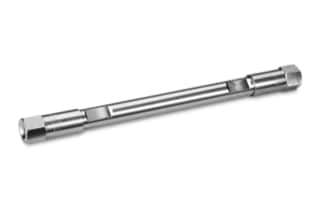
|
Chemistry |
C8 |
|
Separation Mode |
Reversed Phase |
|
Particle Substrate |
Silica |
|
pH Range Min |
2 pH |
|
pH Range Max |
8 pH |
|
Maximum Pressure |
6000 psi (415 Bar) |
|
Endcapped |
Yes |
|
Silanol Activity |
Low |
|
Particle Shape |
Spherical |
|
Particle Size |
3.5 µm |
|
Endfitting Type |
Waters |
|
Pore Size |
100 Å |
|
Format |
Method Validation Kit |
|
Surface Area |
340 |
|
System |
HPLC |
|
Particle Technology |
Silica |
|
USP Classification |
L7 |
|
Inner Diameter |
4.6 mm |
|
Length |
100 mm |
|
Carbon Load |
12 % |
|
UNSPSC |
41115709 |
|
Brand |
SunFire |
|
Product Type |
Column Kits |
|
Units per Package |
3 pk |

SunFire Silica C8 Method Validation Kit, 100Å, 3.5 µm, 4.6 mm X 100 mm, 3/pk
Due to its low pH stability, the SunFire C8 Column has a longer column lifetime than many standard silica-based HPLC columns. To achieve high efficiency and improved sensitivity, the SunFire C8 Column integrates patented, cutting-edge silica synthesis, bonding, end-capping, and packing techniques.
With the addition of this SunFire Silica C8 Method Validation Kit, you will have access to three of the most advanced SunFire Silica C8 Columns, which have a longer column lifetime than many standard silica-based HPLC columns in addition to low pH stability. SunFire C8 Columns achieve great efficiency and sensitivity by utilizing unique, cutting-edge silica synthesis, end-capping, and packing techniques.
SunFire C8 Column is suitable for a wide range of mass spectrometry applications. The lab equipment has sharp peaks, exceptional sensitivity, large peak capacity, and ultra-low bleed. Furthermore, the SunFire C8 Column offers high resolution, low back pressure, and fast analysis, saving you time and money.
You can rely on the SunFire C8 Column to provide consistent chromatographic results over the life of the column, the method, and your new product. This is due to the analytical column's purpose of generating new analysis processes for the most recent pharmaceutical and biopharmaceutical items. The SunFire C8 Column will exhibit the same excellent repeatability year after year, batch after batch, and column after column.
The SunFire C8 Columns in the Method Validation Kit are manufactured using high-purity raw materials under tight quality control and packing procedures, ensuring that only high-quality lab equipment enters your lab. Shop for lab equipment and select the equipment that best suits you and your laboratory needs from a broad selection of Waters products and offerings
We also recommend you review SunFire C8 VanGuard Cartridge, 100Å, 3.5 µm, 3.9 mm X 5 mm, 3/pk. The VanGuard Cartridge is intended to protect and extend the life of your SunFire C8 column. This is performed by removing all chemical and particle contaminants from the mobile phase, ensuring that your analysis is always accurate, precise, and dependable.
What Is The Recommended Storage Method For SunFire C8 Columns?
The SunFire C8 Column should be stored at room temperature in 100 percent acetonitrile for periods longer than four days. If the temperature is high, store the column in 100 percent acetonitrile immediately after use to ensure that it lasts a long time. If a buffer salt was used in the mobile phase, flush the column with 10 column volumes of HPLC grade water and replace it with 100 percent acetonitrile for storage; otherwise, the buffer salt could precipitate inside the column.